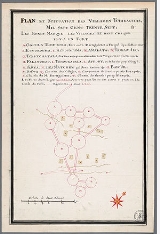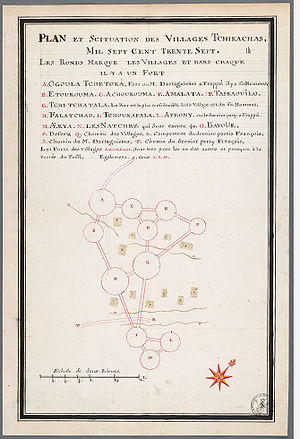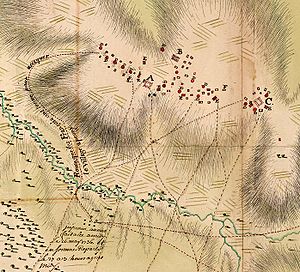
Battle of Ackia
Encyclopedia

Introduction
The Chickasaw Campaign of 1736 consisted of two pitched battles by the French and allies against ChickasawChickasaw
The Chickasaw are Native American people originally from the region that would become the Southeastern United States...
fortified villages in present day Northeast Mississippi. Under the overall direction of the governor of Louisiana
Louisiana (New France)
Louisiana or French Louisiana was an administrative district of New France. Under French control from 1682–1763 and 1800–03, the area was named in honor of Louis XIV, by French explorer René-Robert Cavelier, Sieur de la Salle...
, Jean-Baptiste Le Moyne de Bienville, a force from Upper Louisiana attacked Ogoula Tchetoka on March 25, 1736. A second force from Lower Louisiana attacked Ackia on May 26, 1736. Both attacks were bloodily repulsed (see Atkinson, 2004).
Strategic Situation
The French empire of New FranceNew France
New France was the area colonized by France in North America during a period beginning with the exploration of the Saint Lawrence River by Jacques Cartier in 1534 and ending with the cession of New France to Spain and Great Britain in 1763...
extended from New Orleans
History of New Orleans
The history of New Orleans, Louisiana traces the city's development from its founding by the French, through its period under Spanish control, then back to French rule before being sold to the United States in the Louisiana Purchase...
in the south to Canada
History of Canada
The history of Canada covers the period from the arrival of Paleo-Indians thousands of years ago to the present day. Canada has been inhabited for millennia by distinctive groups of Aboriginal peoples, among whom evolved trade networks, spiritual beliefs, and social hierarchies...
in the north. Its unity was disrupted only by the presence of hostile Natchez
Natchez people
The Natchez are a Native American people who originally lived in the Natchez Bluffs area, near the present-day city of Natchez, Mississippi. They spoke a language isolate that has no known close relatives, although it may be very distantly related to the Muskogean languages of the Creek...
and Chickasaw tribes in the lower Mississippi River
Mississippi River
The Mississippi River is the largest river system in North America. Flowing entirely in the United States, this river rises in western Minnesota and meanders slowly southwards for to the Mississippi River Delta at the Gulf of Mexico. With its many tributaries, the Mississippi's watershed drains...
valley. The French effort to reduce these hostile tribes and gain free passage along the Mississippi culminated in the Chickasaw Wars
Chickasaw Wars
The Chickasaw Wars were fought in the 18th century between the Chickasaw allied with the British against the French and their allies the Choctaws and Illini. The Province of Louisiana extended from Illinois to New Orleans, and the French fought to secure their communications along the Mississippi...
.
Since 1716, the French and Choctaw
Choctaw
The Choctaw are a Native American people originally from the Southeastern United States...
had united against the Natchez in an overt campaign of destruction. By 1736 the Natchez were killed or scattered, with many of them taking refuge among the Chickasaw. Bienville wanted to destroy these Natchez remnants, and reduce the Chickasaw: 'It is absolutely necessary that some bold and remarkable blow be struck, to impress the Indians with a proper sense of respect and duty toward us.' He planned coordinated operations by two forces: one under Pierre d'Artaguette, commander of the Illinois District of Louisiana, from the North; and a larger army under himself from the South. These forces were to meet 'at the Chickasaw villages' on March 31, 1736.
Battle of Ogoula Tchetoka
D'Artaguette at Fort de ChartresFort de Chartres
Fort de Chartres was a French fortification first built in 1720 on the east bank of the Mississippi River in present-day Illinois. The Fort de Chartres name was also applied to the two successive fortifications built nearby during the 18th century in the era of French colonial control over...
collected detachments throughout the Illinois Country
Illinois Country
The Illinois Country , also known as Upper Louisiana, was a region in what is now the Midwestern United States that was explored and settled by the French during the 17th and 18th centuries. The terms referred to the entire Upper Mississippi River watershed, though settlement was concentrated in...
and proceeded with great expedition to Chickasaw Bluff
Chickasaw Bluff
The term Chickasaw Bluff refers to high ground rising about above the flood plain between Fulton in Lauderdale County, Tennessee and Memphis in Shelby County, Tennessee. Composed of eroded Pleistocene loess over Pliocene glacial gravel, they are slide prone...
at present day Memphis. Despite failing to meet promised detachments under de Monchervaux and de Grandpré, he resumed his march with Chicagou
Chief Chicagou
Chief Chicagou, also known as Agapit Chicagou, was an 18th century Native American leader of the Mitchigamea. He visited Paris and participated in the Chickasaw Wars.- Paris :...
and de Vincennes
François-Marie Bissot, Sieur de Vincennes
François Marie Bissot, Sieur de Vincennes was a French Canadian explorer and soldier who established several forts in what is now the U.S. state of Indiana, including Fort Vincennes....
to the Chickasaw lands, only to be advised by courier that the southern army was late and that he should act according to his own judgement.
Unable or unwilling to wait any longer, d'Artaguette arrived before a seemingly isolated village at Ogoula Tchetoka (part of Chuckalissa, or Old Town
Old Town (Mississippi)
Old Town was a Chickasaw village in northeast Mississippi in present-day Lee County.Old Town was located at ....
in present day northwest Tupelo, Mississippi
Tupelo, Mississippi
Tupelo is the largest city in and the county seat of Lee County, Mississippi, United States. It is the seventh largest city in the state of Mississippi, smaller than Meridian, and larger than Greenville. As of the 2000 United States Census, the city's population was 34,211...
) with 130 French regulars and militia and 366 Iroquois
Iroquois
The Iroquois , also known as the Haudenosaunee or the "People of the Longhouse", are an association of several tribes of indigenous people of North America...
, Arkansas
Quapaw
The Quapaw people are a tribe of Native Americans who historically resided on the west side of the Mississippi River in what is now the state of Arkansas.They are federally recognized as the Quapaw Tribe of Indians.-Government:...
, Miami
Miami tribe
The Miami are a Native American nation originally found in what is now Indiana, southwest Michigan, and western Ohio. The Miami Tribe of Oklahoma is the only federally recognized tribe of Miami Indians in the United States...
, and Illinois
Illiniwek
The Illinois Confederation, sometimes referred to as the Illiniwek or Illini, were a group of twelve to thirteen Native American tribes in the upper Mississippi River valley of North America...
warriors. The day was 'Palm Sunday', March 25. Leaving 30 French behind to guard supplies, d'Artaguette's northern force attacked with 'great vigor' but was pinned down, routed, and furiously pursued, and its baggage train of valuable shot and powder was captured. Surviving remnants scattered back to meet the belated de Monchervaux on the return trail; Bienville wrote that, without the firm resistance given by the Iroquois and Arkansas, not a single Frenchman would have survived. According to French reports, twenty-one of the French were captured of whom nineteen, including d'Artaguette thrice wounded in battle, were executed by burning, some of whom were already dead when thrown into large fires. Two Frenchmen were held in hope of exchange for an imprisoned Chickasaw chief, but were eventually sent to the British in South Carolina.
A contemporary memoir by Dumont de Montigny
Dumont de Montigny
Jean-François-Benjamin Dumont de Montigny, or Dumont de Montigny, was born in Paris on July 31, 1696, and died sometime after 1753. His writings about the French colony of Louisiana include a two-volume history published in 1753, as well as an epic poem and a prose memoir preserved in manuscript...
mistakenly reported this battle as taking place on May 20, 1736, leading to confusion in many later accounts.
Battle of Ackia
Ackia (in present day south Tupelo, MississippiTupelo, Mississippi
Tupelo is the largest city in and the county seat of Lee County, Mississippi, United States. It is the seventh largest city in the state of Mississippi, smaller than Meridian, and larger than Greenville. As of the 2000 United States Census, the city's population was 34,211...
) was attacked by the Southern force. The French contingent, including grenadiers, regulars, Swiss, and various companies of militia, assembled at Mobile throughout March, 1736. Starting the first of April, the French proceeded by boat with little loss 270 river miles up the Tombigbee River. On April 23, the army reached its forward depot at Fort Tombecbé
Fort Tombecbe
Fort Tombecbe , also spelled Tombecbee and Tombeché, was a stockade fort located on the Tombigbee River near the border of French Louisiana, in what is now Sumter County, Alabama. It was constructed under the leadership of Jean-Baptiste Le Moyne, Sieur de Bienville in 1736-37 as trading post about...
(which had been prepared at present day Jones Bluff, Sumter County, Alabama
Sumter County, Alabama
Sumter County is a county of the U.S. state of Alabama.Its name is in honor of General Thomas Sumter of South Carolina. As of 2010, the population was 13,763. Its county seat is Livingston.-History:...
in anticipation of this campaign), and there mustered 544 European and 45 African men, excluding officers, before being met up-river by a 600 man Choctaw contingent. Departing Fort Tombecbé on May 4 by boat and on foot, the combined army continued upriver and reached the vicinity of present day Amory, Mississippi
Amory, Mississippi
Amory is a city in Monroe County, Mississippi, United States. The population is 6,956 as of the 2000 census.-History:Amory was the first planned city in Mississippi. The Kansas City, Memphis & Birmingham Railroad needed a mid-point between Memphis, Tennessee and Birmingham, Alabama for their...
on May 22. Quickly fortifying a base camp to protect the supplies and boats, essential for its return, the army departed on May 24 for the nearest Chickasaw village, located about 20 miles across the prairie to the northwest.
On May 26, the army approached three fortified hilltop villages, named Ackia, Tchoukafalaya, and Apeony, collectively called Long Town. After some debate the army advanced to attack, with the French contingent in typically European order, and the Choctaw noisily but reluctantly covering the flanks. Avoiding Apeony, where a trader's cabin flew a British flag, the force stormed Ackia under cover of large shields or mats called mantelets. The French immediately received 'a shower of balls' from the Chickasaw fortifications, and the mantelets proved to be ineffective. The attack became pinned down on the side of the hill with steadily mounting casualties. Several outlying cabins were taken, but after several hours' combat the French fell back 'without having been able to make the slightest breach' in the fortress at the point of attack. During the night the Chickasaws further improved their position by razing surrounding cabins and vegetation. The French, short of ammunition and provisions, and worried that they could not carry any more wounded, and with no information from d'Artaguette, retreated the way they came.

Assessment
B. F. French stated 'The war was rashly brought and rashly conducted. Bienville entered the enemy's country without any means of siege, made one attack on a fort, and then, without attempting by scouts to open a communication with D'Artaguette, whom he had ordered to meet him in the Chickasaw country on the 10th of May [sic], or making any attempt to give him proper orders, without even taking one Chickasaw prisoner to get any information of D'Artaguette's proceedings, he retreated, and ended the campaign disastrously.' Atkinson described as 'stupid' the frontal assaults against positions that were practically invincible. A Frenchman's relation of the observations of a Choctaw chief named Red Shoes is quoted by Atkinson: 'The French did not know at all the way to carry on war; we had been able to take only a little village of thirty of forty men; that on the contrary we had lost many men without being able to say that we had killed a single one; that our troops heavily clad marched with too slow a step and so close together that it was impossible for the Chickasaws to fire without killing some of them and wounding several.'The Chickasaw were amply equipped with English arms via a trade route from the English and small Chickasaw settlements in South Carolina
Savannah Town, South Carolina
Savannah Town, South Carolina was first observed in the 1670s as a Westo village, located on the Savannah River below the fall line in present day Aiken County. The Savannah displaced the Westos in a 1679-1680 trade war, and the town bore their name on a 1685 Joel Gascoyne Plat of the Province of...
and Georgia. Their
rectangular palisade forts with loopholed walls were complimented by round fortified houses, also with loopholes. With this technology the Chickasaw invincibly maintained their homeland against relentless pressure from the French and Choctaw, including a repeat campaign in 1739
Chickasaw Wars
The Chickasaw Wars were fought in the 18th century between the Chickasaw allied with the British against the French and their allies the Choctaws and Illini. The Province of Louisiana extended from Illinois to New Orleans, and the French fought to secure their communications along the Mississippi...
and numerous small attacks by Choctaws for the next 20 years.
A village once thought to possess archaeological remains of Ackia battleground was made a U.S. National Monument
U.S. National Monument
A National Monument in the United States is a protected area that is similar to a National Park except that the President of the United States can quickly declare an area of the United States to be a National Monument without the approval of Congress. National monuments receive less funding and...
in 1938. The National Park Service realized only a few years after establishment of the National Monument that Ackia and the battle were not located there, and it was absorbed into the Natchez Trace Parkway
Natchez Trace Parkway
The Natchez Trace Parkway is a National Park Service unit in the southeastern United States that commemorates the historic Old Natchez Trace and preserves sections of the original trail....
in 1961. It is now called 'Chickasaw Village.' Research 25 years later, however, determined that the actual site of Ackia and its neighboring villages are in a developed area of south Tupelo. A subdivision called 'Lee Acres' covers the site of the 1736 Battle of Ackia, cited by historians as a pivotal rebuff to French territorial ambitions in the Southeast.
External links
- "Ackia Battleground National Monument", a 1938 article from the National Park Service
- The French-Chickasaw War of 1736 Part I
- The French-Chickasaw War of 1736 Part II (Ackia)
- TopoQuest - Location of d'Artaguette's Battlefield. The location shown on this map, since 1934 marked by a stone DAR monument, was determined to be instead located at Tupelo.
- Bienville's report of d'Artaguette's attack

